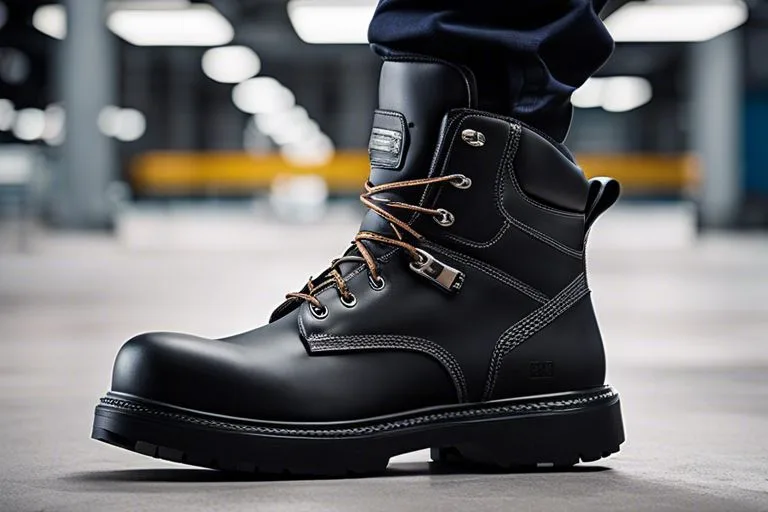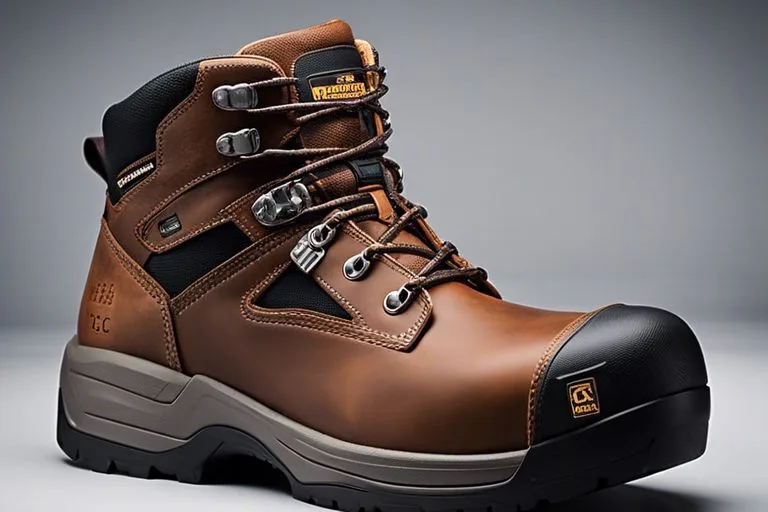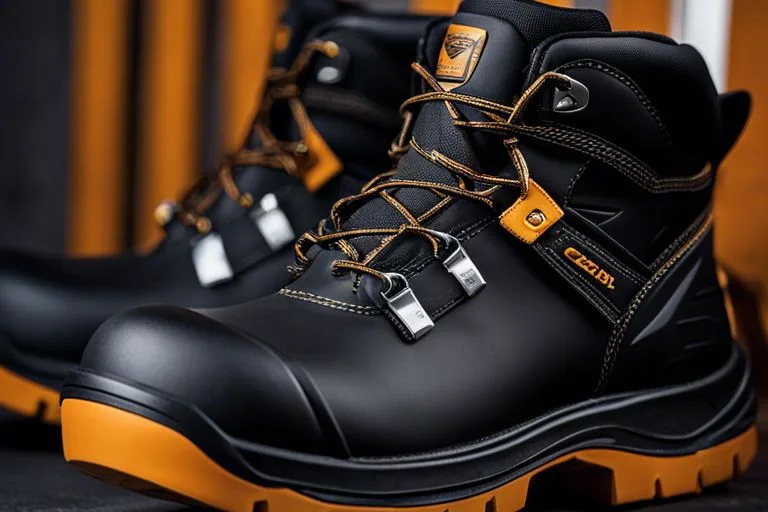In today’s fast-paced and demanding work environments, protecting your feet is crucial. When it comes to heavy-duty work, composite toe work boots have become a popular choice for men who need durable and protective footwear. These boots are designed to provide maximum protection for your feet while also being lightweight and comfortable to wear. Over the years, there has been a significant evolution in the design and technology of men’s composite toe work boots, making them more reliable and efficient than ever before.
If you work in an industry where heavy objects or potential foot hazards are a daily concern, it’s essential to invest in a pair of high-quality composite toe work boots. Throughout this blog post, we will explore the evolution of these boots, highlighting their improved safety features, innovative materials, and how they have become an indispensable piece of equipment for anyone working in hazardous environments.
The Early Days of Protective Footwear
The history of protective footwear for men at work dates back to ancient times, where workers wore sandals made of thick leather or wood. These early forms of protective footwear were designed to shield the feet from sharp objects and rough terrain, providing a basic level of safety for manual laborers.
Historical Footwear for Men at Work
In the 17th and 18th centuries, the industrial revolution brought about the need for more robust and protective footwear for men working in hazardous environments, such as factories and mines. Traditional leather boots were reinforced with metal components to provide added protection against heavy machinery and falling objects. While effective in some aspects, these steel-toed boots were heavy and cumbersome, often causing discomfort and fatigue for the wearer.
From Steel to Composite: A Material Revolution
In the late 20th century, advancements in material science led to the development of composite toe caps as a lightweight alternative to traditional steel. These modern materials, such as carbon fiber, kevlar, and fiberglass, provided the same level of protection as steel but with a significant reduction in weight. This breakthrough revolutionized the design of men’s work boots, offering a more comfortable and agile solution without compromising safety.
You can appreciate the shift from steel to composite toe caps, as it significantly reduces the weight of your work boots, making them more comfortable to wear during long hours of work. Additionally, composite toe caps provide the same level of protection as their steel counterparts, ensuring your safety in hazardous work environments.
Understanding Composite Materials
While researching men’s work boots, you may have come across the term ‘composite toe’. This refers to the material used in the toe cap of the boot to provide protection. Understanding composite materials is important when choosing the right work boot for your needs. You can explore a range of men’s work boots with composite toe at Men’s Work boots | Safety boots & occupational footwear.
What Are Composite Materials?
Composite materials are made from two or more different materials that, when combined, create a new material with enhanced properties. In the case of work boots, the composite toe is often made from a combination of materials such as Kevlar, carbon fiber, plastic, or fiberglass. These materials are chosen for their strength, durability, and lightweight properties.
Advantages of Composite Materials in Footwear
One of the main advantages of using composite materials in footwear, particularly in the toe cap, is the lightweight nature of the material. This can make a significant difference in the comfort level of your work boots, especially if you need to wear them for long hours. In addition, composite materials offer excellent protection against impacts and compressions, meeting or exceeding safety standards for protective footwear. Another advantage is that composite materials are non-metallic, making them ideal for workplaces with metal detectors, as they won’t set off alarms.
The Development of Composite Toe Work Boots
Lastly, let’s delve into the development of composite toe work boots. Over the years, manufacturers have worked tirelessly to evolve the design and materials used in these specialized work boots, aiming to provide you with the best possible protection without compromising on weight and comfort.
Initial Designs and Challenges
When composite toe work boots first hit the market, they faced several challenges. The initial designs were often criticized for being too bulky and heavy, which defeated the purpose of providing a lightweight alternative to steel toe boots. Additionally, early composite materials were not as durable and reliable as they are today, posing potential risks to your safety on the job.
Breakthroughs in Composite Toe Technology
Fortunately, significant breakthroughs in composite toe technology have revolutionized the industry. Manufacturers have developed advanced materials, such as carbon fiber, Kevlar, and fiberglass, which offer superior protection while remaining remarkably lightweight. These materials have been extensively tested to ensure that they meet or exceed safety standards, providing you with peace of mind as you work in hazardous environments.

Heavy Duty Meets Lightweight
Despite their heavy-duty construction, men’s composite toe work boots have evolved to become much lighter. This is due to advancements in materials and manufacturing processes, as well as a focus on ergonomic design. As a result, you no longer have to sacrifice comfort for protection when it comes to your work footwear.
When it comes to heavy-duty yet lightweight work boots, the Helly Hansen Work Boots – Helly Safety Boot Range stands out. These boots are designed to provide exceptional protection without weighing you down, making them ideal for long days on the job.
The Balancing Act: Protection vs. Comfort
One of the challenges in designing men’s composite toe work boots is striking the right balance between protection and comfort. While you need your boots to provide ample protection against impact and compression, they also need to be comfortable enough for all-day wear. The use of high-quality, lightweight materials and innovative design techniques allows for boots that offer optimal protection without sacrificing comfort. This means you can focus on your work without being distracted by discomfort or fatigue.
The Impact on Mobility and Fatigue
Aside from carrying the weight of heavy-duty materials, bulky work boots can also have a significant impact on your mobility and fatigue levels. The evolution of men’s composite toe work boots has addressed this issue by reducing the overall weight of the boots while still providing excellent protection. This means that your mobility is no longer hindered, and you can move more freely throughout your workday. Additionally, the lighter weight can also help reduce fatigue, allowing you to stay energized and focused on your tasks.
Safety Standards and Certifications
Now let’s talk about the safety standards and certifications that are essential for composite toe work boots. Understanding these standards will help you make an informed decision when choosing the right pair for your specific work environment. Safety standards ensure that the boots you wear provide adequate protection for your feet in various hazardous situations.
Understanding ASTM and ANSI Ratings
When it comes to safety standards for work boots, two organizations are primarily responsible for setting the guidelines: ASTM International and the American National Standards Institute (ANSI). ASTM develops and publishes technical standards for various materials, products, systems, and services, including work boots. Their standards cover a wide range of requirements for protective footwear, such as impact resistance, compression resistance, and protection against electrical hazards. ANSI, on the other hand, focuses on establishing voluntary consensus standards for a variety of products, including safety footwear. It’s important to look for boots that are compliant with both ASTM and ANSI standards to ensure maximum protection for your feet in the workplace.
How Composite Toe Boots Meet or Exceed Safety Requirements
Composite toe work boots are designed and tested to meet or exceed the safety requirements set by ASTM and ANSI. The use of composite materials such as carbon fiber, Kevlar, or plastic in the toe cap ensures that the boots offer excellent protection without adding unnecessary weight. Composite toe boots are lighter than traditional steel toe boots but still provide the same level of impact and compression resistance. This means that you can move freely and comfortably while knowing that your feet are well-protected from potential hazards. Additionally, composite toe boots are non-conductive, making them an excellent choice for those who work in environments with electrical hazards.
The Modern Composite Toe Work Boot
Your search for the perfect work boot may be over with the modern composite toe work boot. These boots have evolved to provide you with the best combination of durability, safety, and comfort. The advancements in materials and design have led to a new generation of work boots that are heavy-duty yet lightweight, making them an essential piece of gear for any professional in demanding work environments.
Innovations in Boot Design and Functionality
One of the most significant developments in modern composite toe work boots is the use of advanced composite materials. These materials provide exceptional protection against impact and compression, meeting or exceeding the safety standards set for traditional steel-toe boots. In addition to safety, these boots are designed with ergonomic features to reduce fatigue and improve overall comfort during long workdays. The incorporation of moisture-wicking technology and breathable lining materials ensures that your feet stay dry and comfortable, even in the harshest conditions.
Consumer Trends and the Demand for Durable, Lightweight Boots
As consumer awareness of workplace safety and comfort grows, there is an increasing demand for work boots that offer both durability and lightweight construction. The modern composite toe work boot meets these demands with innovative design and superior craftsmanship. With an emphasis on durability, these boots are built to withstand the toughest job sites while providing the comfort and support necessary for all-day wear. The reduction in weight compared to traditional steel-toe boots also enhances mobility and reduces fatigue, making them a popular choice among professionals in various industries.

Caring for Your Composite Toe Work Boots
To keep your Chippewa Boots: Quality Craftsmanship composite toe work boots in top condition and ensure their longevity, it is essential to properly care for them. By following a few simple maintenance tips, you can extend the life of your boots and continue to benefit from their durability and protection on the job.
Maintenance Tips to Extend Boot Life
Proper care and maintenance of your composite toe work boots are key to extending their lifespan. To start, always clean your boots after each use. Use a soft brush to remove dirt and debris, particularly from the seams and crevices. This prevents the accumulation of abrasive particles that can cause premature wear and tear.
Regularly inspect your boots for any signs of damage, such as cracks or tears in the material. If you notice any issues, address them immediately to prevent further deterioration. Additionally, apply a protective waterproofing treatment to keep the material strong and supple, and prevent water damage.
- Clean your boots after each use with a soft brush
- Regularly inspect for signs of damage
- Apply a protective waterproofing treatment
To ensure your boots remain in optimal condition, it is important to follow these maintenance tips regularly, as they can significantly extend the life of your work boots and save you money in the long run. Perceiving the importance of proper care and taking proactive steps to maintain your boots will be beneficial in the long term.
Recognizing When to Replace Your Work Boots
Despite your best efforts to care for your composite toe work boots, there will come a time when they need to be replaced. It is crucial to recognize when your boots have reached the end of their serviceable life. Signs that indicate it’s time to replace your work boots include visible physical damage, such as cracks or tears in the material, worn-out soles with decreased tread depth, and a loss of structural support around the toe area.
When your boots no longer provide the necessary protection, support, and comfort required for your work environment, it is essential to invest in a new pair to ensure your safety and well-being. By recognizing these indicators and acting accordingly, you can avoid potential hazards and continue to perform at your best.
Conclusion
So, if you are in the market for a durable and reliable pair of work boots, the evolution of men’s composite toe work boots is a trend worth exploring. With advancements in materials and design, these boots offer the perfect combination of heavy-duty protection and lightweight comfort. Whether you are working in construction, manufacturing, or any other trade that requires safety footwear, investing in a pair of composite toe work boots can provide you with the peace of mind and support you need to get the job done.
With a range of options available, you can find a pair of work boots that suits your specific needs and preferences. From waterproofing and insulation to slip-resistant soles and cushioned insoles, the evolution of men’s composite toe work boots has brought about a new era of functionality and convenience for those who rely on their footwear for protection on the job. So, take the time to explore the latest offerings and find a pair that will keep you safe and comfortable throughout your workday.
FAQ
Q: What are composite toe work boots?
A: Composite toe work boots are a type of safety footwear designed to protect the toes from heavy objects and compression. Unlike traditional steel toe boots, composite toe boots are made from non-metal materials such as Kevlar, plastic, or carbon fiber, making them lighter and often more comfortable to wear.
Q: What are the benefits of composite toe work boots?
A: Composite toe work boots provide protection similar to steel toe boots but with the added benefits of being lightweight and non-conductive. They are ideal for workers who are required to pass through metal detectors, as they do not set off alarms. Additionally, composite toe boots are often more comfortable to wear for long periods of time due to their lighter weight.
Q: Are composite toe work boots as durable as steel toe boots?
A: While composite toe work boots are typically lighter than steel toe boots, they are just as durable and meet the same safety standards for impact and compression protection. They are designed to withstand the same level of impact as steel toe boots, making them a reliable choice for industrial and construction work environments.
Q: Do composite toe work boots provide the same level of protection as steel toe boots?
A: Yes, composite toe work boots are tested to the same safety standards as steel toe boots and provide comparable protection against falling objects and compression. The non-metal materials used in composite toe boots are engineered to absorb and disperse impact forces, ensuring the safety of the wearer in hazardous work environments.
Q: Can I wear composite toe work boots in extreme temperatures?
A: Composite toe work boots are designed to be versatile and are suitable for use in a wide range of temperatures. They are often equipped with insulation and moisture-wicking features to keep feet comfortable in both hot and cold conditions. However, it is essential to select a pair of boots that are specifically rated for the temperature extremes you may encounter in your work environment.

